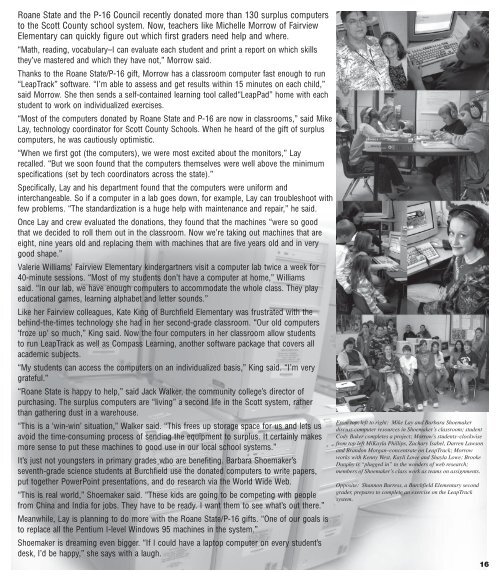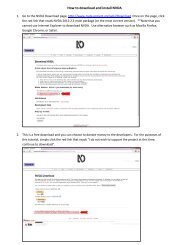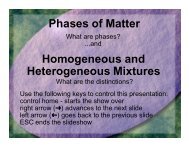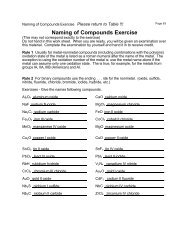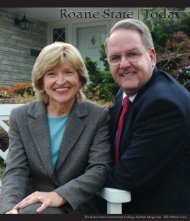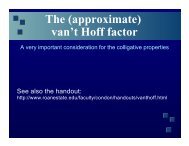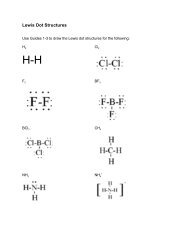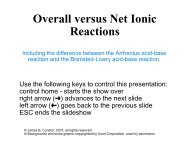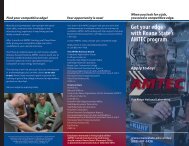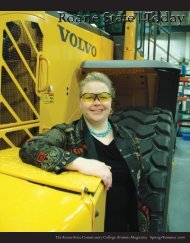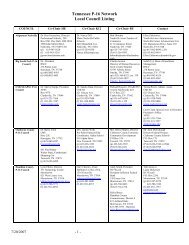Alumni Magazine.indt - Roane State Community College
Alumni Magazine.indt - Roane State Community College
Alumni Magazine.indt - Roane State Community College
You also want an ePaper? Increase the reach of your titles
YUMPU automatically turns print PDFs into web optimized ePapers that Google loves.
<strong>Roane</strong> <strong>State</strong> and the P-16 Council recently donated more than 130 surplus computersto the Scott County school system. Now, teachers like Michelle Morrow of FairviewElementary can quickly figure out which first graders need help and where.“Math, reading, vocabulary–I can evaluate each student and print a report on which skillsthey’ve mastered and which they have not,” Morrow said.Thanks to the <strong>Roane</strong> <strong>State</strong>/P-16 gift, Morrow has a classroom computer fast enough to run“LeapTrack” software. “I’m able to assess and get results within 15 minutes on each child,”said Morrow. She then sends a self-contained learning tool called“LeapPad” home with eachstudent to work on individualized exercises.“Most of the computers donated by <strong>Roane</strong> <strong>State</strong> and P-16 are now in classrooms,” said MikeLay, technology coordinator for Scott County Schools. When he heard of the gift of surpluscomputers, he was cautiously optimistic.“When we first got (the computers), we were most excited about the monitors,” Layrecalled. “But we soon found that the computers themselves were well above the minimumspecifications (set by tech coordinators across the state).”Specifically, Lay and his department found that the computers were uniform andinterchangeable. So if a computer in a lab goes down, for example, Lay can troubleshoot withfew problems. “The standardization is a huge help with maintenance and repair,” he said.Once Lay and crew evaluated the donations, they found that the machines “were so goodthat we decided to roll them out in the classroom. Now we’re taking out machines that areeight, nine years old and replacing them with machines that are five years old and in verygood shape.”Valerie Williams’ Fairview Elementary kindergartners visit a computer lab twice a week for40-minute sessions. “Most of my students don’t have a computer at home,” Williamssaid. “In our lab, we have enough computers to accommodate the whole class. They playeducational games, learning alphabet and letter sounds.”Like her Fairview colleagues, Kate King of Burchfield Elementary was frustrated with thebehind-the-times technology she had in her second-grade classroom. “Our old computers‘froze up’ so much,” King said. Now the four computers in her classroom allow studentsto run LeapTrack as well as Compass Learning, another software package that covers allacademic subjects.“My students can access the computers on an individualized basis,” King said. “I’m verygrateful.”“<strong>Roane</strong> <strong>State</strong> is happy to help,” said Jack Walker, the community college’s director ofpurchasing. The surplus computers are “living” a second life in the Scott system, ratherthan gathering dust in a warehouse.“This is a ‘win-win’ situation,” Walker said. “This frees up storage space for us and lets usavoid the time-consuming process of sending the equipment to surplus. It certainly makesmore sense to put these machines to good use in our local school systems.”It’s just not youngsters in primary grades who are benefiting. Barbara Shoemaker’sseventh-grade science students at Burchfield use the donated computers to write papers,put together PowerPoint presentations, and do research via the World Wide Web.“This is real world,” Shoemaker said. “These kids are going to be competing with peoplefrom China and India for jobs. They have to be ready. I want them to see what’s out there.”Meanwhile, Lay is planning to do more with the <strong>Roane</strong> <strong>State</strong>/P-16 gifts. “One of our goals isto replace all the Pentium I-level Windows 95 machines in the system.”Shoemaker is dreaming even bigger. “If I could have a laptop computer on every student’sdesk, I’d be happy,” she says with a laugh.From top, left to right: Mike Lay and Barbara Shoemakerdiscuss computer resources in Shoemakerʼs classroom; studentCody Baker completes a project; Morrowʼs students–clockwisefrom top left MiKayla Phillips, Zachary Isabel, Darren Lawsonand Brandon Morgan–concentrate on LeapTrack; Morrowworks with Kenny West, Kayli Lowe and Shayla Lowe; BrookeDunphy is “plugged in” to the wonders of web research;members of Shoemakerʼs class work as teams on assignments.Opposite: Shannon Burress, a Burchfield Elementary secondgrader, prepares to complete an exercise on the LeapTracksystem.16


